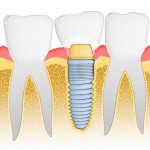
Screw retained restorations were the main approach during the early years of dental implant treatment but the cement-retained restoration gradually becoming more popular. The aim of this review is to compare the outcomes of screw- and cement-retained implant restorations.
The Medline, Embase, the Cochrane Oral Health Group Trials Register, and the Cochrane Central Register of Controlled Trials (CENTRAL) databases were searched for English language articles. Randomized clinical trials (RCTs) Prospective and retrospective cohort studies involving Screw- or cement-retained restoration were included. Studies were evaluated and data extracted independently by 3 reviewers and 2 clinicians. The major outcome variable was implant or crown loss, and the minor outcome variables were screw loosening, de-cementation, and porcelain fracture.
- 24 studies were included (1 RCT; 8 prospective cohort; 9 retrospective cohort; 5 in vitro)
- For major failures data was extracted from 17 papers. For each paper with both retention types, the data were separated by retention type, yielding 25 studies for analysis.
- The major failure rate was 0.87 per 100 years (95% CI: 0.00, 11.03) for studies with cement retention type, and 0.71 per 100 years (95% CI: 0.00, 15.65) for studies with screw retention.
- The difference in failure rates between these two retention types was not statistically significant (p = 0.54).
- The overall failure rate between these two retention types was 0.81 per 100 years (95% CI: 0, 6.85).
- The overall failure rate of screw loosening was 3.66 per 100 years (95% CI: 0.0, 49.37) [data from 11 studies]
- The overall failure rate from de-cementation was 2.54 per 100 years (95% CI: 0, 16.30, [data from 14 studies]
The authors concluded
There is no significant difference between cement- and screw-retained restorations for major and minor outcomes with regard to implant survival or crown loss. This is important data, as clinicians use both methods of restoration, and neither is a form of inferior care
Comment
With a large number of clinical studies available for comparison the decision to include the in-vitro studies is unusual. And given the increase risk of recall and selection bias with retrospective studies there is an argument for only including the 9 prospective studies in this review. In additional only English language studies were included so there is teh possibility that other relevant studies could have been missed.
Links
Sherif S, Susarla HK, Kapos T, Munoz D, Chang BM, Wright RF. A Systematic Review of Screw- versus Cement-Retained Implant-Supported Fixed Restorations. J Prosthodont. 2013 Dec 31. doi: 10.1111/jopr.12128. [Epub ahead of print] PubMed PMID: 24382004.
